Creating Add-Ons
Add-ons are fixed recurring fees that can be linked to your core plans in Billsby. You can choose whether you want to make an add-on mandatory or optional, just as you can choose whether you want to charge for the add-on, or include it in the plan for free.
Add-ons are billed in advance at the start of each billing cycle, alongside the cost of the product, plan, and cycle the customer has subscribed to.
Selling add-ons to your existing customers is an easy way to up-sell services to your customers, without having to move them to a new plan. With Billsby's services, you can:
- Create unlimited add-ons
- Set-up bundling rules - requiring customers to select certain add-ons with specific plans
- Add new add-ons whenever you like with no development required
This will help you increase your revenue and generate growth within your business, providing your customers with more options, flexibility and freedom of choice with their plans.
Creating add ons
To create a new add-on, select Products > Add-Ons.
Here, you will be able to create your first add-on.

In the section titled, 'Tell Us the Basics' you will be asked to provide a name, display name, and a description for your add-on.
If you decide on a unit based pricing structure for your add-on, you will also need to provide the singular and plural unit name so that we know exactly how to reference it when coordinating with your customers.
The single unit name is the title we'll use when we refer to one unit of your add-on. This name will be shown to your customers in the Billsby Checkout, Self-Service Account Management, relevant emails and invoices, alongside being displayed in the Billsby control panel.
The plural unit name is the title we'll use when we refer to multiple units of your add-on.
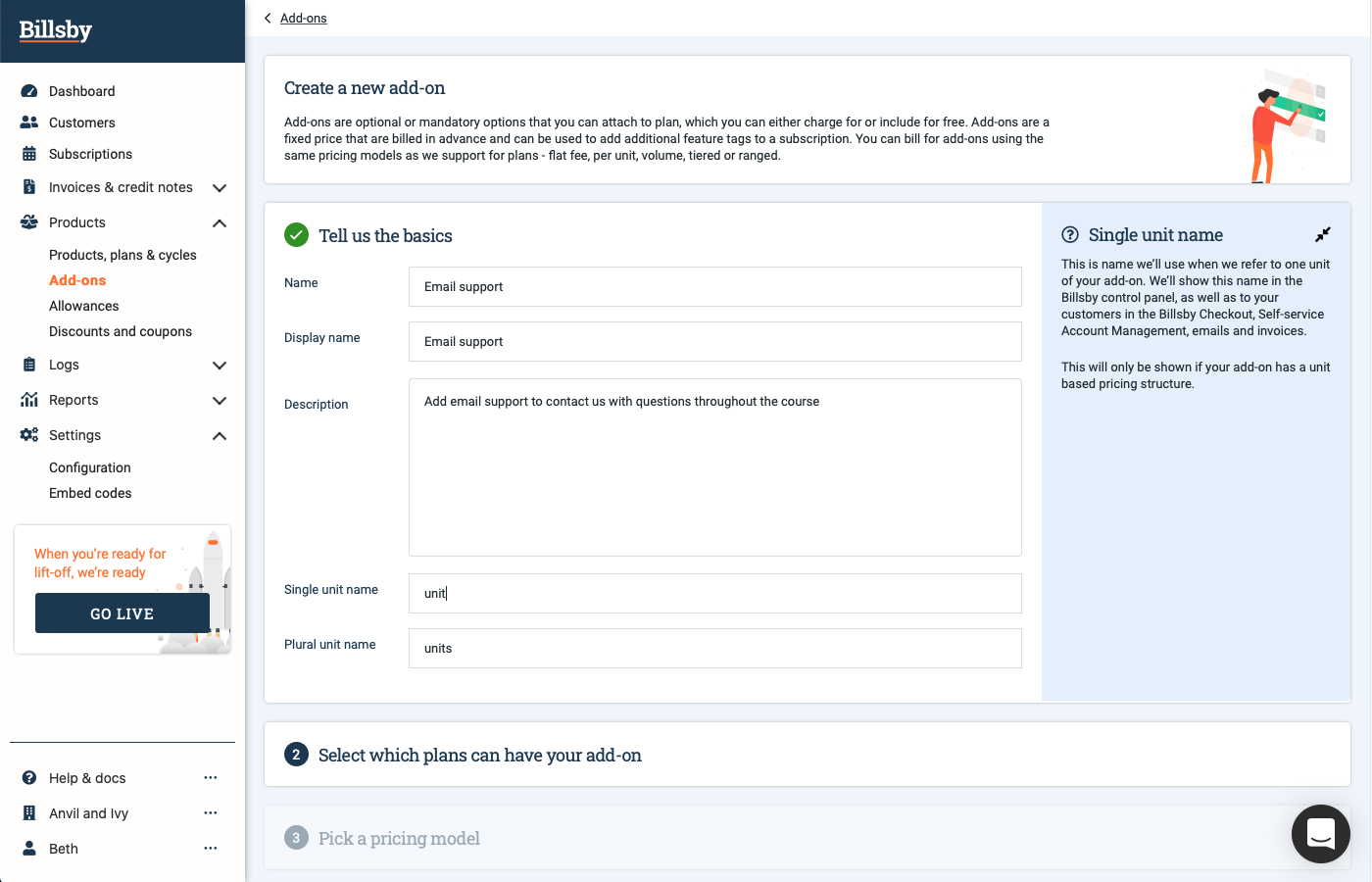
Linking add-ons to plans
Next, you'll need to select which plans can have access to your add-on, and whether it should be a compulsory element of the plan or not.
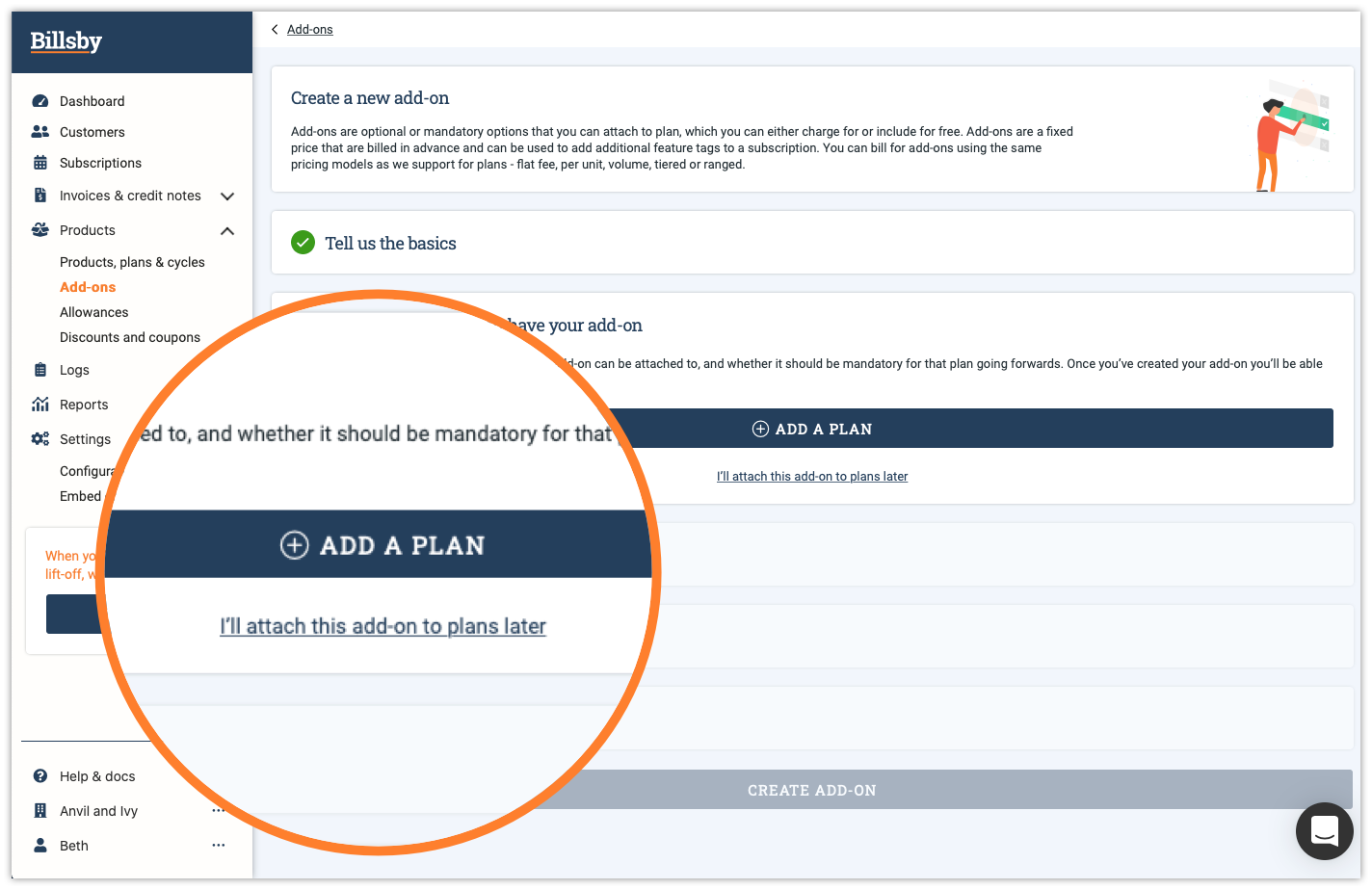
If you want to make the add-on a compulsory element of the plan, then select 'Force Allowance with Plan'. This will automatically add the add-on to your customer's subscription during the checkout flow and they will not be able to remove it.
If you decide not to make the add-on compulsory then the customer will be free to choose whether they want to include it during the checkout flow or not.

If a customer subscribes to your product during a free trial, all mandatory add-ons will also be added to the subscription for no additional cost. By default, however, the customer will not be able to add optional add-ons to their subscription during their free trial period.
This restriction can be changed in the Checkout and Account Management section of configuration. To access this, simply navigate to Configuration > Checkout and Account Management > Self-Service and then switch on the toggle labelled 'Manage Add-Ons'.

Once you've created your add-on(s), you do not have to immediately attach them to a plan. You can select the button, 'I'll attach this add-on to plans later' to postpone this action.
Pricing model
There's a range of pricing models for you to choose from when creating your add-ons such as,
- Flat fee
- Per unit
- Volume
- Tiered
- Ranged
Please note, once you have selected a pricing model, this cannot be changed.
For more information on what each of these pricing structures entail, please refer to our documentation on plans here.

Once you've attached your add-on to a plan you'll be able to set the price for it. This action cannot be completed beforehand as the pricing of the add-on is dependent on the cycle length of the plan it is attached to.
Configuring the cost of the add-on
In order to configure a price for your add-on you should base your figure on the cycle lengths within the linked plan.
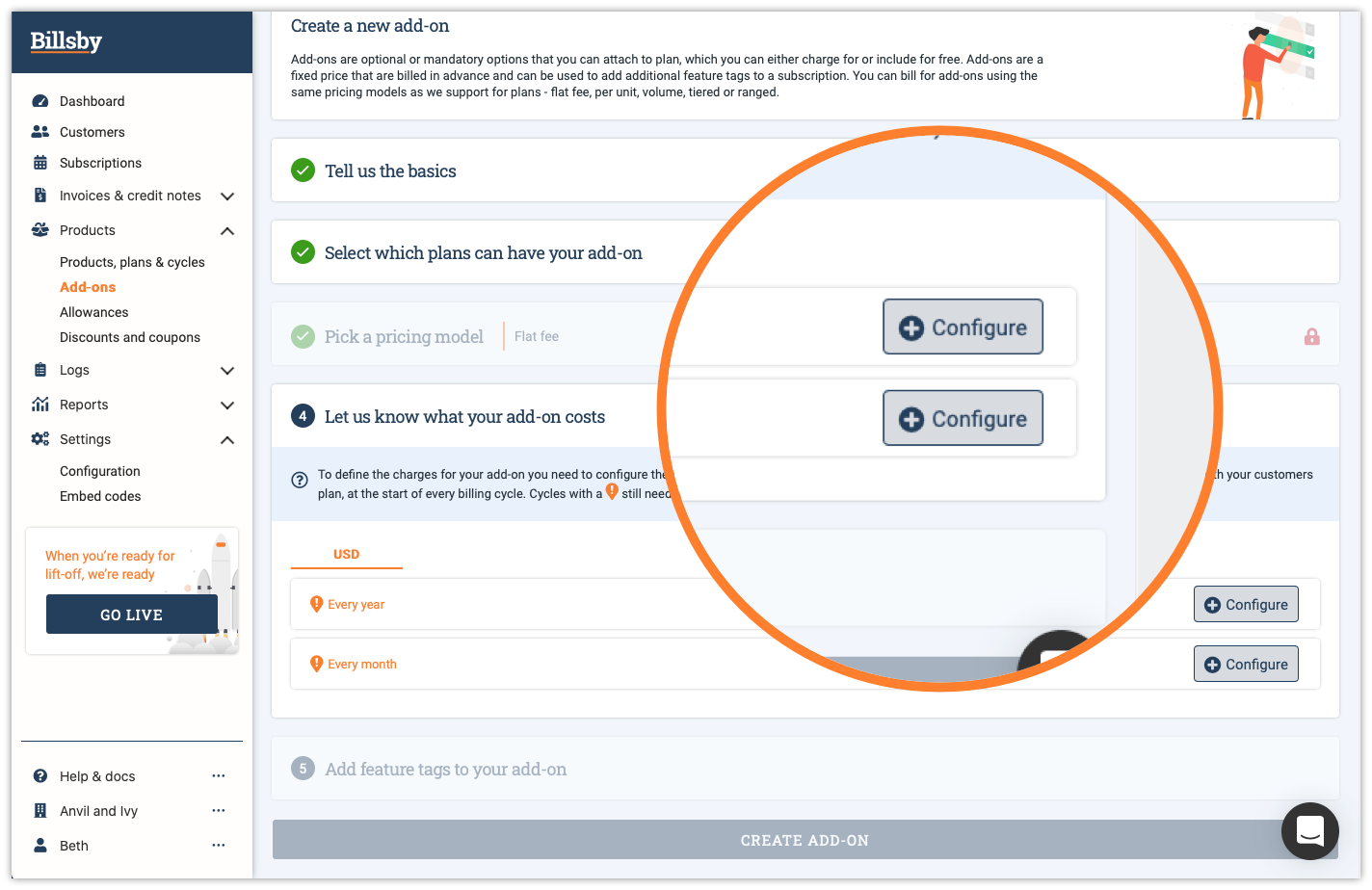
Once you have set-up your add-on you can link it to as many plans as you'd like. If the add-on is linked to multiple plans with the same cycle frequency and currency, then you'll only need to configure the add-on price for that cycle frequency once.
For example, if you have two plans that have the same cycle frequency of once a month, then you'll only need to configure a price for that frequency once, as it can be applied over again.
The configured price should automatically be used across all of the linked plans of that same cycle length and currency.
Here at Billsby, when you link an additional plan to an add-on, we will automatically check for any cycle lengths that have already been configured. If we find a match then we will then assign the previously configured cycle prices to the newly linked plan. Just to save you some time.
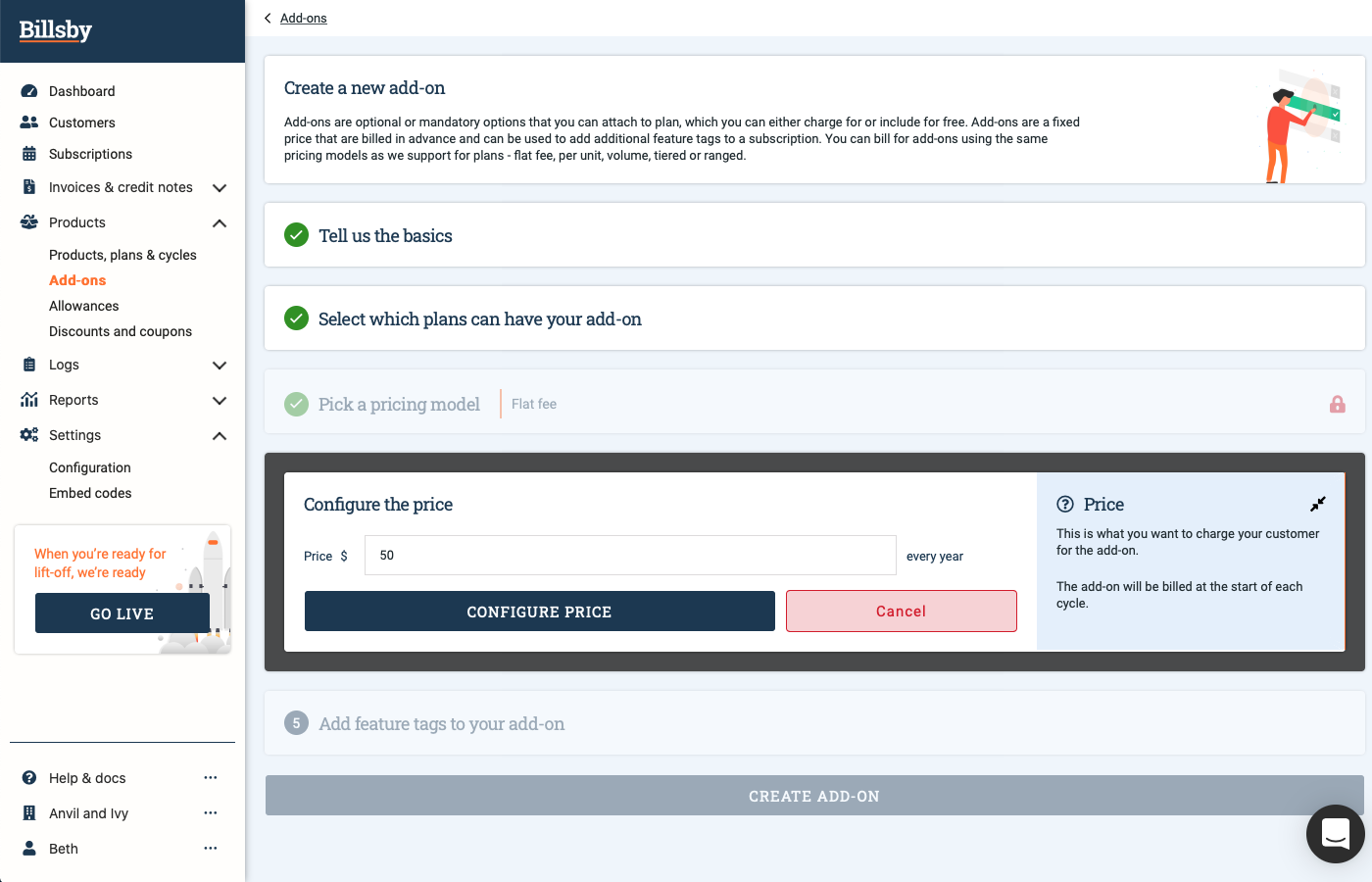
However, if the cycle lengths are the same but the currency isn't, then this rule doesn't apply and you will need to configure the cycle prices for your add-ons separately, according to each currency.
Unit based add-ons
With per unit billing, the customer chooses how many units of your add-on they want, and then agrees to pay a fixed price for each unit.
For example, if you operated a video streaming service you could charge $5 per extra viewing device and then allow the customer to choose upfront how many extra devices they want to add to their plan - if any.
Likewise, for any mandatory unit based add-ons, the customer would have to specify the number of units of the add-on they would like to add to their subscription each cycle.
Editing the number of units of add-ons
Customers are able to change the number of units of the add-on they are subscribed to at any time, whether the add-on is compulsory or not.
This can be achieved using the self service account management feature or, alternatively you could perform this change for them directly using the Billsby control panel.
Any changes made to the number of units will only come into effect at the start of the next billing cycle, as this avoids the process of having to give customers pro-rated refunds mid-cycle.
Feature tags
With the implementation of feature tags, this will allow your developers to only think about the features that your customer has, rather than the plan they're on. This will simplify the process of understanding what the customer has access to.
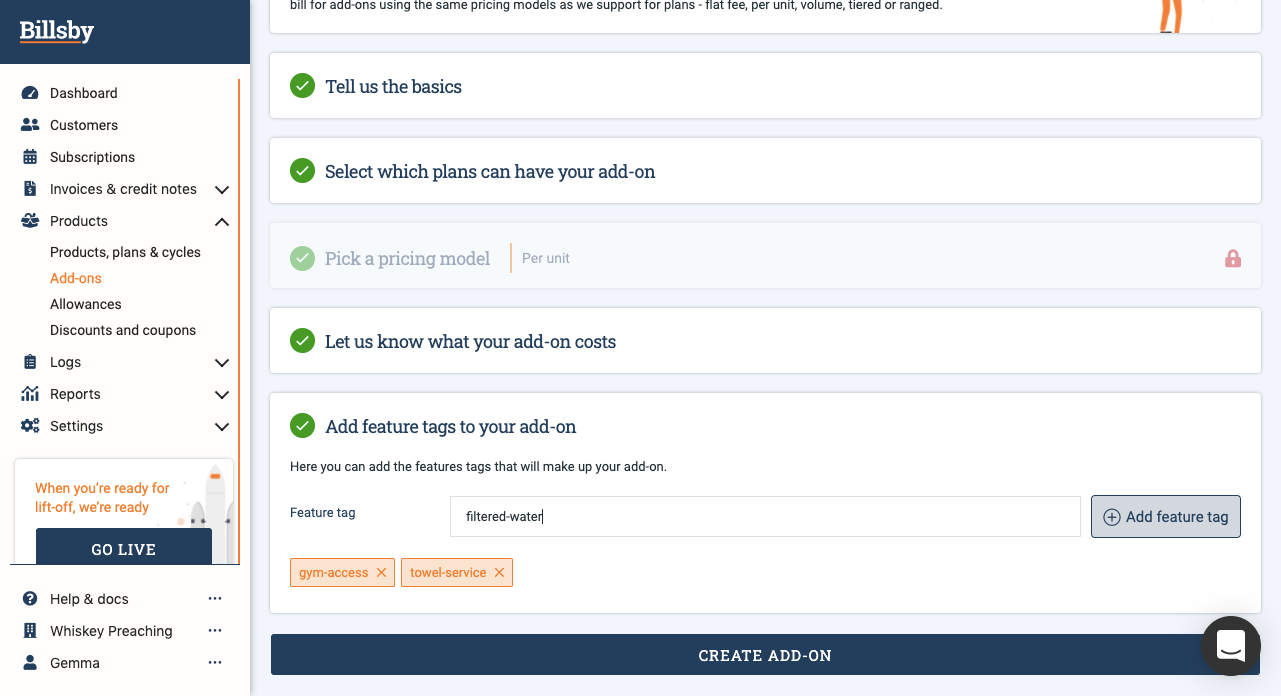
Here's an example of feature tags in action:
| Basic Plan | Premium Plan | Also available via add-on |
|---|---|---|
| Gym access | Gym access | No |
| Towel service | No | |
| Filtered water | Yes |
Because the 'Filtered Water' feature is also available through an add-on in addition to the premium plan, this means that customers on a basic plan can buy the 'Filtered Water' add-on. Your developers just have to check for the 'Filtered Water' feature tag when the customer tries to use the machine.
Deleting an optional add-on
An optional add-on can be deleted in two ways. Customers are able to delete the optional add-on themselves by using the self service account management feature or, alternatively, you can delete it for them directly through the subscriptions page in the Billsby control panel.
Any changes made to an add-on, such as a change in the number of units the customer wants to receive, or a permanent deletion will only come into effect at the start of the next billing cycle. Customers should still have access to the additional add-on features until next month's rollover takes place as this avoids the process of having to give customers pro-rated refunds mid-cycle.
FAQs
How do I link an add-on to a plan?
If you head to Products > Add-ons you can add an add-on to one of your plans. You either need to create an add-on by selecting 'Add a new add-on' in the top right-hand corner of the screen. In the add-on creation process step 2 will let you attach your add-on to a plan.
If the add-on already exists, simply hit 'Edit' on the add-on and you'll see a list of all the plans with the selected add-on. Just hit 'Add a plan' and you'll see all the plans that you can attach to the add-on.
How do I force an add-on with a plan?
You may wish to make an add-on a mandatory part of a plan. You can do this using the 'Force add-on with plan' toggle next to the plans you have selected to have access to the add-on. You can change this at anytime by heading to Products > Add-ons > Edit, and hitting the toggle beside the 'Force add-on with plan'.
Can I change the pricing model of an add-on?
No, once you have selected a pricing model, this cannot be changed without creating a new add-on.
How do I delete an add-on?
If you head to Products > Add-ons, you'll be able to see a list of all the add-ons that have been created in your Billsby account. Here, you can delete the add-on by clicking 'Delete' on the right side of the add-on.
If the add-on is linked to a plan, you must head to Products > Add-ons > Edit > Plans with this add-on. Here you must remove the linked plans and save your changes in order to delete this add-on.
Can I add an add-on image?
Yes! You can upload an image to be shown to customers in the checkout and self-service account management. In step 1 of creating an add-on, just hit the 'Add-on image' toggle and then upload your image. Files must be a minimum of 400 x 400 in size and high resolution .png or .jpeg files work best - we’ll resize to suit.
Updated about 4 years ago
